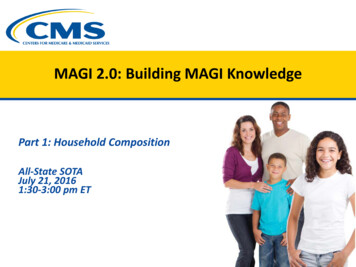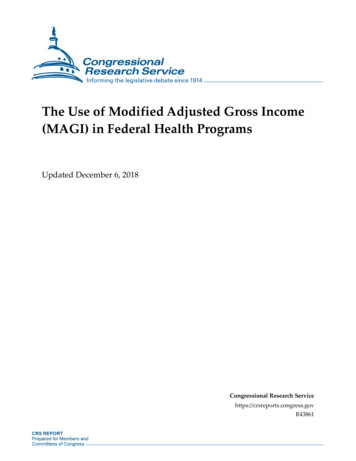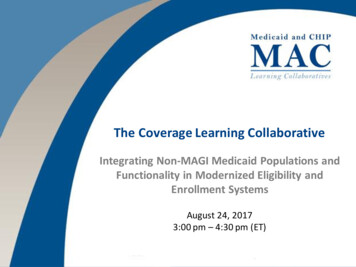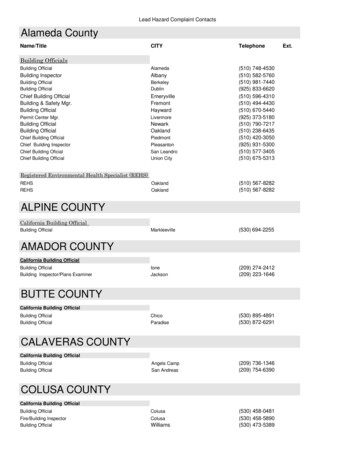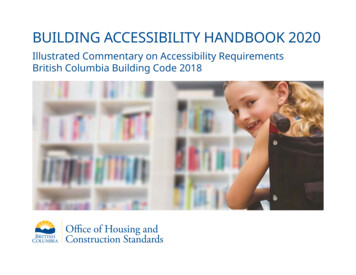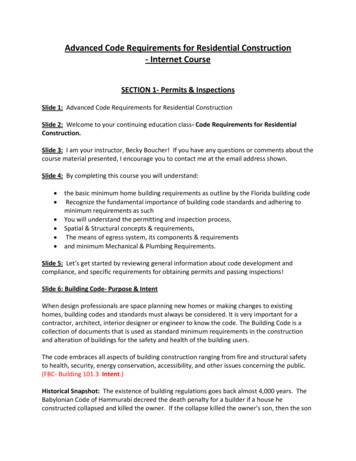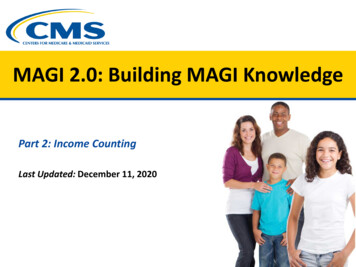
Transcription
MAGI 2.0: Building MAGI KnowledgePart 2: Income CountingLast Updated: December 11, 2020
Introduction
Setting the Stage3 In 2020, the Centers for Medicare and Medicaid Services (CMS) updated a trainingmanual originally developed in 2013 to help states and eligibility workers understandand apply Modified Adjust Gross Income (MAGI)-based rules for Medicaid and theChildren’s Health Insurance Program (CHIP). The manual is available at ition-and-income-training.zip. This MAGI 2.0: Building MAGI Knowledge slide deck serves as a companion to theHousehold and MAGI Income Training Manual, providing more details on how toapply the MAGI-based income counting rules. The issues and scenarios reviewed in this slide deck were developed in response tofrequently asked technical assistance questions raised by states and revised based onupdated guidance that was released.
Two-Part ResourceDetermining Household Composition4Calculating Household IncomeFocus of This Resource
Determining Household IncomeKey Questions When Determining Household Income:Whose income is counted?What income is counted?Over what period is income counted?5
Whose Income Is Counted?6Generally, to determine MAGI-based household income: Count the MAGI-based income of adults in the household. Do not count the MAGI-based income of children in thehousehold.Let’s discuss this rule
Income Counting Rules7Regulatory Requirements Household income includes theMAGI-based income of allindividuals in the MAGI-basedhousehold, with specificexceptions. Special rules exist for countingthe income of children and taxdependents.Relevant Regulatory Language:42 CFR 435.603(d)(1)Household income is the sum of the MAGI-based income of everyindividual included in the individual’s household [unless an exceptionapplies].42 CFR 435.603(d)(2)(i)The MAGI-based income of an individual who is included in thehousehold of his or her parent and is not expected to be required tofile a tax return is not included in household income whether or notthe individual files a tax return.42 CFR 435.603(d)(2)(ii)The MAGI-based income of a tax dependent [claimed by someoneother than a parent] who is not expected to be required to file a taxreturn is not included in the household income of the taxpayerwhether or not such tax dependent files a tax return.
Special Income Counting Rule for ChildrenA child’s income is excluded from total household income if:1The child is either under age 19* or is an adult child claimed by a parent asa tax dependent;2The child and parent are both included in the MAGI-based household; and3The child’s income is below the tax filing threshold (i.e., the child is notexpected to be required to file a tax return for the current tax year).*At state option, includes children aged 19 or 20 who are full-time students Includes stepparents42 CFR 435.603(d)(2)(i)8
Special Income Counting Rule for Children (cont’d)9Discussion This rule applies whether household composition is based on: The rules for tax filers under 435.603(f)(1) or (f)(2); or The non-filer rules described in 435.603(f)(3) for non-filers and exceptions for taxdependents claimed by non-parents listed in 435.603(f)(2)(i)-(iii). It does not matter whether the child actually files a tax return. Sometimes members of the same family have different MAGI-based households. The rule isapplied separately to each household. This may result in the child’s income counting for onehousehold and not for another. When determining the total household income of a child who is not living with a parent (forexample, a child living with a grandparent), the child’s MAGI-based income is always countedin determining the child’s eligibility, even if the child’s income is below the tax filingthreshold.
Special Income Counting Rule for Tax DependentsA tax dependent’s income is excluded from total household income if:1The tax dependent and the tax filer who expects to claim the dependentare both included in the household; and2The tax dependent’s income is below the tax filing threshold (i.e., the taxdependent is not expected to be required to file a tax return for the currenttax year).42 CFR 435.603(d)(2)(ii)10
Special Income Counting Rule for Tax Dependents (cont’d)11Discussion Some Medicaid households include tax dependents other than the taxpayer’s children, such asnieces/nephews or parents of the tax filer. The special income counting rule for tax dependents appliesin the case of tax dependents who are claimed by someone other than a parent. The tax dependent does not need to be within a specific age range. The rule applies to any MAGI-based household that includes both the tax filer and tax dependent (e.g.,the tax filer’s household and the households of dependents who are children of the tax filer). When determining the total household income of a tax dependent who is claimed by someone otherthan a parent, the tax dependent’s MAGI-based income is always counted in determining his/her owneligibility, even if the income does not meet the tax filing threshold.– Such a tax dependent’s household would not include the claiming tax filer due to the exception at42 CFR 435.603(f)(2)(i). This means that the tax dependent’s income would not be excluded fromhis own household income under this rule.– Exception in unusual situation: In the event that such a tax dependent’s household (establishedusing the non-filer rules described at 435.603(f)(3)) includes the tax dependent’s parent, the taxdependent’s income would be excluded from his own household income.
What Does It Mean to Have Income Below the Tax FilingThreshold? The Internal Revenue Service (IRS) establishes annualtax filing thresholds that explain at what income levelan individual is required to file taxes. The thresholds vary depending on tax filing status(e.g., single filer, joint filer, single dependent). The IRS updates the threshold amounts annually.2019 Tax Filing ThresholdSingle dependents (under age 65) are required to file a tax return if any of the following apply:1. Unearned income more than 1,100;2. Earned income more than 12,200;3. Gross income more than the larger of:a) 1,100; orb) Earned income (up to 11,850) plus 350.https://www.irs.gov/pub/irs-pdf/p501.pdf12
Applying the Tax Filing Threshold for Children and TaxDependents13Discussion Using information obtained during the application process, the agency can compare the childor tax dependent’s income against the tax filing threshold. Because the tax filing thresholds differ for earned and unearned income, the agency willneed to separate income into earned and unearned income types to compare against theappropriate threshold. The tax filing threshold for the current year is not available until the next tax filing season, sothe agency can compare current income against the threshold for the prior tax year. Forexample, in determining eligibility in December 2020, the agency can use the 2019 tax filingthreshold to determine whether a child’s income is counted toward the household MAGI.Federally Facilitated Marketplace (FFM) Practice:In determining whether an individual’s income meets the tax filing threshold, the FFM uses the prioryear tax filing threshold for single dependents because:o The prior year filing requirement is the most current information available;o Most children and tax dependents applying for coverage will qualify as single dependents; ando The filing threshold for married dependents mirrors that of single dependents, except when thedependent’s spouse expects to file a separate return and itemize deductions.
Applying the Income Rules for Children & Tax Dependents14These rules apply: Regardless of the tax dependent’s age; and Whether or not the individual actually files a tax return.*At state option includes children aged 19 or 20 and a full-time student
Whose Income Is Counted?Scenario 115Scenario: Marty expects to claim his adult son, Mark (age 22), who is a full-time student, as a taxdependent. Marty makes 1,500 a month. Mark makes 600 a month working as a waiter.MAGI-Based Household: Marty and Mark will be included in each other’s MAGI-based households.Question: What is the total household income?
Whose Income Is Counted?Scenario 1 (cont’d)Scenario: Marty expects to claim his adult son, Mark (age 22), who is a full-time student, as a taxdependent. Marty makes 1,500 a month. Mark makes 600 a month working as a waiter.Question: Is Mark’s income excluded from Marty and Mark’s total household income under thespecial income counting rule for children?Answer: Yes. Mark’s income would be excluded from total householdincome under the special income counting rule for children.16
Whose Income Is Counted?Scenario 217Scenario: Laura and Neil expect to file jointly and claim their son, Jonny (age 18), as a tax dependent.Laura and Neil each make 1,600 a month. Jonny earns 1,100 a month at his job.MAGI-Based Household: Laura, Neil, and Jonny will all be included in each other’s MAGI-basedhouseholds.Question: What is the total household income?
Whose Income Is Counted?Scenario 2 (cont’d)18Scenario: Laura and Neil expect to file jointly and claim their son, Jonny (age 18), as a tax dependent.Laura and Neil each make 1,600 a month. Jonny earns 1,100 a month at his job.Question: Is Jonny’s income excluded from total household income under the special income countingrule for children?Answer: No. Jonny’s income would be included in total householdincome under the special income counting rule for children.
Whose Income Is Counted?Scenario 319Scenario: Aunt Mary expects to claim her nephew, Matthew (age 16), as a tax dependent. Aunt Maryearns 2,500 a month in wages. Matthew earns 450 a month from his part-time job.MAGI-Based Household: Aunt Mary’s MAGI-based household will include herself and Matthew, butMatthew’s MAGI-based household will include only himself.Question: What is the total household income for Aunt Mary and Matthew?
Aunt Mary’s Total Household IncomeScenario 3 (cont’d)20Scenario: Aunt Mary expects to claim her nephew, Matthew (age 16), as a tax dependent. AuntMary earns 2,500 a month in wages. Matthew earns 450 a month from his part-time job.Question: Is Matthew’s income excluded from Aunt Mary’s total household income under thespecial income counting rule for tax dependents?Answer: Yes. Matthew’s income would be excludedfrom Aunt Mary’s household income under thespecial income counting rule for tax dependents.
Matthew’s Total Household IncomeScenario 3 (cont’d)21Scenario: Aunt Mary expects to claim her nephew, Matthew (age 16), as a tax dependent. AuntMary earns 2,500 a month in wages. Matthew earns 450 a month from his part-time job.Question: Is Matthew’s income excluded from his own total household income under the specialincome counting rule for tax dependents?Answer: No. Matthew’s income would be not beexcluded from his own household income under thespecial income counting rule for tax dependents
Social Security Benefits and the Tax Filing Threshold All Social Security benefits are counted as part of an individual’s MAGI-based income. However, in determining whether a child or tax dependent’s income is expected to meet the filingthreshold, only the taxable portion of Social Security benefits is counted. IRS Publication 915 describes:1. How to determine whether any portion of Social Security benefits maybe taxable; and2. If a portion of benefits may be taxable, how to determine the actualtaxable all the 2019 Tax Filing ThresholdSingle dependents (under age 65) are required to file a tax return if any of the following apply:1. Unearned income more than 1,100;2. Earned income more than 12,200; andSocial Security benefits are3. Gross income more than the larger of:unearned income.a) 1,100; orb) Earned income (up to 11,850) plus 350.22
Should Social Security Benefits Be Applied Toward the TaxFiling Threshold?23 To determine whether any of a child or tax dependent’s Social Security benefits applies towardthe tax filing threshold, first determine whether any portion of those benefits may be taxable. Complete Worksheet A in IRS Publication 915 (shown below). If the amount in line E is greaterthan the base amount of 25,000, then a portion of benefits may be taxable.
Determining Whether Social Security Benefits Are Taxable24Scenario: A child receives 2,000 per month in Social Security survivors benefits. The child has noother source of earned or unearned income.Question: Is any portion of these benefits taxable?Complete Worksheet A (IRS Publication 915) 24,000 12,000 0 0 12,000Answer: The amount on line E ( 12,000) is less than the base amount ( 25,000), so no portion ofthe child’s Social Security benefits would be taxable.In order for any of the child’s Social Security benefits to be taxable, this child would need to haveother taxable income (line C) and/or tax-exempt interest (line D) of more than 13,000.
Whose Income Is Counted?Scenario 4Scenario: Grandpa Albert expects to claim his grandson, Harry (age 15), as a tax dependent. GrandpaAlbert earns 1,000 a month in wages. Harry receives 550 a month in Social Security survivor benefits.MAGI-Based Household: Grandpa Albert’s MAGI-based household will include himself and Harry, butHarry’s MAGI-based household will include only himself.Question: What is the total household income for Grandpa Albert and Harry?25
Harry’s Social Security BenefitsScenario 4 (cont’d)26Scenario: Grandpa Albert expects to claim his grandson, Harry (age 15), as a tax dependent. Grandpa Albertearns 1,000 a month in wages. Harry receives 550 a month in Social Security survivor benefits.Question: When determining the total household income for Grandpa Albert, would any portion of Harry’sSocial Security income be applied toward the filing threshold?Complete Worksheet A (IRS Publication 915) 6,600 3,300 0 0 3,300 The amount on line E ( 3,300) is less than the base amount ( 25,000), so no portion of Harry’sSocial Security benefits would be taxable.Because only the taxable portion of an individual’s Social Security benefits are applied towardthe filing threshold, none of Harry’s Social Security benefits would be counted in determiningwhether or not he would be required to file taxes.
Grandpa Albert’s Total Household IncomeScenario 4 (cont’d)27Scenario: Grandpa Albert expects to claim his grandson, Harry (age 15), as a tax dependent. Grandpa Albertearns 1,000 a month in wages. Harry receives 550 a month in Social Security survivor benefits.Question: Is Harry’s income excluded from Grandpa Albert’s total household income under the specialincome counting rule for tax dependents?Answer: Yes. Harry’s income would be excluded fromGrandpa Albert’s total household income under thespecial income counting rule for tax dependents.
Harry’s Total Household IncomeScenario 4 (cont’d)28Scenario: Grandpa Albert expects to claim his grandson, Harry (age 15), as a tax dependent. GrandpaAlbert earns 1,000 a month in wages. Harry receives 550 a month in Social Security survivor benefits.Question: Is Harry’s income excluded from his own total household income under the special incomecounting rule for tax dependents?Answer: No. Harry’s income would be included in hisown total household income under the specialincome counting rule for tax dependents.
Social Security Benefits and the Tax Filing Threshold29Discussion To review:– All Social Security benefits are counted toward MAGI-based income.– The relationship between Social Security benefits and the tax filing threshold is only relevant indetermining whether a child or tax dependent’s MAGI-based income (which includes Social Securitybenefits) is included in total household income. Only the taxable portion of Social Security benefits is applied toward the tax filing threshold. So if noportion of the Social Security benefits is taxable, none of those benefits will be applied toward the taxfiling threshold. Except in rare cases, such as receipt of a lump sum payment, a child or tax dependent’s Social Securitybenefits will not be taxable unless the child/tax dependent has other income which itself (i.e., notcounting Social Security benefits) exceeds the tax filing threshold. If a child or tax dependent’s income does count toward total household income, all Social Securitybenefits are counted (both the taxable portion and the non-taxable portion).FFM Practice: When evaluating whether an individual meets the tax filing threshold, theFFM never considers any of the individual’s Social Security benefits.
Determining Household IncomeKey Questions When Determining Household Income:Whose income is counted?What income is counted?Over what period is income counted?30
Taxable Income and Adjustments31The IRS Form 1040 is the starting place to understand what income and adjustments areincluded in MAGI. We will refer back to it throughout this section.Page 1Page 2
What Income Is Counted?32MAGI for purposes of advance payments of premium tax credits (APTC)/costsharing reductions (CSR) includes:1. Adjusted gross income (taxable income less deductions/adjustments)2. Social Security benefits not included in taxable incomeAPTC/CSR Eligibility3. Tax-exempt interest4. Foreign earned income26 U.S.C. 36B(d)(2)(B)Medicaid/CHIP MAGI-based income includes:1. Adjusted gross income (taxable income less deductions/adjustments),excluding:Medicaidand CHIPEligibility Certain taxable American Indian/Alaska Native income Taxable scholarships/awards used for educational purposes2. Social Security benefits not included in taxable income3. Tax-exempt interest4. Foreign earned income42 CFR 435.603(e)
Countable and Non-Countable Income
Special Rules for Medicaid/CHIP34MAGI-based income, which is used to determine eligibility for Medicaid/CHIP, has important differencesfrom MAGI used by the Marketplace to determine eligibility for APTC/CSRIncome TypeEducational scholarships, awards, orfellowships used for educationalpurposesPayments derived from AmericanIndian/Alaska Native lands, naturalresources, trust settlements, ortraditional/cultural activitiesLump sum payments (i.e., prizes, backpayment of benefits)Cash support provided by atax filer to a tax dependentwho is not a child of the taxfiler (biological, adopted ,orstep)Treatment under MAGIfor APTC/CSRCounted if taxableNot counted if nottaxableCountedCounted as part ofannual income iftaxableTreatment in MAGI-based income forMedicaid/CHIPExcluded from income regardless ofwhether taxable or notExcluded from incomeCounted only in the month received, iftaxable. Converts to resource next month.Not counted if not taxable.Not counted if nottaxableException: Lottery and gambling winnings received onor after January 1, 2018, that exceed 80,000 arecounted not only in the month received, but over aperiod of up to 120 months.Not countedCounted as income of dependent if thestate chooses this option Does not include in-kind support Must exceed nominal amount
How Is Taxable Income Treated in MAGI?35Taxable income counted in determining Medicaid/CHIP MAGI-based income: Taxable wages/salary (before taxesare taken out) Taxable interest Self-employment net income (profitafter subtracting business expenses) Taxable Social Security benefitsAlimony received (for settlementsfinalized on or before December 31,2018) Unemployment benefits Most retirement benefitsRental or royalty income (profit aftersubtracting costs) Net capital gains (profit aftersubtracting capital losses) Most investment income, such asinterest and dividendsOther taxable income, such as canceleddebts, court awards, jury duty pay notgiven to an employer, and gambling,prizes, or awards Taxable income not counted in determining Medicaid/CHIP MAGI-based income: Educational scholarships, awards, or fellowships used for educational purposes Payments derived from American Indian/Alaska Native lands, natural resources, trust settlements, or traditional/culturalactivities42 CFR 435.603(e)(2) and (3)
How Is Non-taxable Income Treated in MAGI?36Non-taxable income not counted in determining Medicaid/CHIP MAGI-based income: Temporary Assistance to Needy Families (TANF) and other government cash assistance Supplemental Security Income (SSI) Child support received Veterans benefits Workers’ compensation payments Proceeds from life insurance, accident insurance, or health insurance Federal tax credits and federal income tax refunds Gifts and loans Inheritances Alimony received (settlements finalized, and certain agreements modified, afterDecember 31, 2018)While many of theseincome types werecountable forMedicaid/CHIP prior toMAGI, they are notcountable for MAGINon-taxable income counted in determining Medicaid/CHIP MAGI-based income: Tax-exempt interest Foreign earned income Non-taxable Social Security benefits (does not include Supplemental Security Income (SSI), which is nevercounted in MAGI) Medicaid/CHIP only: State option to include actual cash support in very narrow circumstances26 U.S.C. 36B(d)(2)(B); 42 CFR 435.603(e) and 435.603(d)(3)
How Are Non-taxable Social Security Benefits Treated inMAGI?37Scenario: Gladys expects to claim her daughter, Ellie (age 17), as a tax dependent. Gladys earns 1,000 from her job and receives 800 in Social Security benefits each month. Ellie has no income.MAGI-Based Household: Gladys and Ellie will be included in each other’s MAGI-based households.Question: What is the total household income for Gladys and Ellie?All of Gladys’s Social Security benefits are included in her MAGI-basedincome, even though none of her Social Security benefits are taxable. GladysEarns 1,000/moReceives 800/mo inSocial SecuritybenefitsGladys and Ellie’sHousehold Size 2Tax filer rules Ellie (17 y/o)Gladys plans to claim Ellieas a tax dependent 1,800/moGladys’s 1,000(Earnings)Gladys’s 800(Social Security)
Researching Complex Income Types
Researching Complex Income Types:Step 1 – IRS Resources39Step 1: Refer to IRS resourcesIRS Publication 525 discusses varioustypes of income and explains whetherthey are taxable or non-taxableIRS.gov has an excellent search feature and helpfulmaterials in the “Help” section (including frequentlyasked questions, or FAQs)
Researching Complex Income Types:Step 2 – CMS and IRS Technical Assistance40Step 2: Submit questions to CMSIf you are unable to find the information you need through the IRS resources:1. Submit your questions to CMS through the SOTA process.2. CMS will work with the IRS to answer the question.3. IRS or CMS will provide a response to the state and share the informationthrough the Eligibility Technical Advisory Group monthly call if appropriate.CMS and the IRS are resources to support states in addressing MAGI questions.
Researching Complex Income Types:Example 1 – AmeriCorps Education Award41Question: Is an AmeriCorps Education Award counted for MAGI-based income?Information from IRS tractors-and-self-employed-5
Researching Complex Income Types:Example 1 – AmeriCorps Education Award (cont’d)Question: Is an AmeriCorps Education Award counted for MAGI-based income?The IRS website indicatesthat AmeriCorps EducationAwards are taxable in theyear they are paid.Taxable income is alwayscounted for MAGI forpurposes of APTC/CSR.However, recall that thereare importantmodifications made toMAGI-based income forMedicaid/CHIP: MAGIbased income excludeseducational scholarships,awards, or fellowships usedfor educational purposes.If the AmeriCorpsEducation Award is usedfor educational purposes(i.e., tuition or payment ofstudent loans), it is notcounted for MAGI-basedincome even though it istaxable.42
Researching Complex Income Types:Example 2 – AmeriCorps Living Allowance43Question: Is an AmeriCorps VISTA member’s living allowance counted for MAGI-based income?IRS Publication 525 instructsAmeriCorps VISTAvolunteers to report theirliving allowance as income,but this conflicts withinformation provided to theapplicant by AmeriCorps.State contacted CMS forthe answer.Source: Section 404 of the Domestic Volunteer Service Act of 1973 (42 U.S.C. § 5044)VISTA living allowances arenot counted for MAGIbased income even thoughthey are taxable under IRSrules.
Deductions
Deductions Must Be Considered in MAGI-Based IncomeStates must incorporate allowable deductions (also known asadjustments) in the calculation of MAGI-based income.45
MAGI Deductions46Included in the Medicaid/CHIP MAGI-based methodologyDeductions and adjustments incorporated into adjusted gross income, including:* Alimony paid to someone else (settlements finalized onor before December 31, 2018) Certain business expenses of performing artists,reservists, and fee-basis government officials Student loan interest paid Health savings account contributions Certain educator expenses Most contributions to individual retirementarrangements (IRAs)Certain self-employment business expenses notincluded in net income Net operating loss Penalties on the early withdrawal of savingsNOT included in the Medicaid/CHIP MAGI-based methodologyCredits and deductions, including: The standard deduction Itemized deductions detailed in Schedule A, such ashome mortgage interest, medical and dentalexpenses, and gifts to charity Child tax credit*List is subject to change
Net Operating Loss Is Applied under MAGI47A net operating loss may occur when an individual’s deductions for a year are more than the individual’sincome for the year. The net operating loss may then be deducted from future year(s) income.In applying MAGI-based methodologies, statesmust subtract net operating loss deductions.
Deductions NOT Incorporated into MAGI-Based Income48Tax creditsandexemptionsare not partof adjustedgross income
Types of Deductions49There are different types of deductions that may be incurred over different time frames.FrequencyExamplesConsistent monthly deduction Alimony paid (settlements finalized on or before December 31, 2018)Student loan interestLump sum deduction Certain educator expensesAnnualized deduction Net operating loss carryoverDeductible part of self-employment taxMany deductions are not commonly claimed by Medicaid/CHIP-eligible individuals: The model single streamlined application asks specifically about deductions for alimony paid and student loaninterest, as these deductions are more common among Medicaid/CHIP-eligible applicants.
Methods to Incorporate Deductions50Different methodologies may be used to incorporate different types of deductions into currentmonthly MAGI-based income.Deduction TypeExamplesConsistent monthlydeduction Lump sum deductionPermissible Methods for Discussion Deduct the monthly expense from current monthlyincome Alimony paid (settlementsfinalized on or beforeDecember 31, 2018)Student loan interest Certain educator expenses Deduct the full amount of the expense from currentmonthly income in the month in which the expensewas incurredDivide the total expense by 12 and deduct onetwelfth from current monthly income Annualizeddeduction Net operating losscarryoverDeductible part of selfemployment tax Divide the total projected expense by 12 and deductone-twelfth from current monthly income
Annualizing Deductions:Scenario51Scenario: Jon is an elementary school teacher. He spends 240 on supplies for his classroom in August.That same month, Jon applies for Medicaid for his 8-year-old daughter, Hazel, whom he expects to claim asa tax dependent.MAGI-Based Household: Hazel’s MAGI-based household will include herself and her father, Jon.Question: How is Jon’s educator expense deduction incorporated into Hazel’s household income for themonth of August?
Incorporating Deductions into MAGI52Discussion The actual amount of an annualized deduction may not be available until the individualcompletes a tax return for the current year. It is reasonable to utilize a projected annualized deduction based on the prior year and toverify the deduction with the prior year tax return. For lump sum deductions that have not yet been incurred, it is reasonable to require theindividual to provide historical documentation of the expense in order to include it inMAGI. A MAGI-based household may have deductions (such as a net operating loss deduction)that exceed their income. If the household MAGI is less than zero once deductions are incorporated, the incomeamount used to determine financial eligibility for Medicaid and CHIP is 0.
Determining Household IncomeKey Questions When Determining Household Income:Whose income is counted?What income is counted?Over what period is income counted?53
Budget Periods54Different budget periods are used to determine financial eligibilityfor Medicaid/CHIP and APTC/CSR.Financial eligibility for Medicaid/CHIP is based on current monthly income.Financial eligibility for APTC/CSR is based on annual income for the calendaryear in which benefits are sought.States have options to minimize churn SSA 1902(e)(14)(H)(i); 26 CFR 1.36B-1(e); 45 CFR 155.305(f)(i)
Medicaid/CHIP Budget Period Options55Objective: Take into account future changes in income that can be reasonably predicted. Promote continuity of coverage.State Options: For Medicaid/CHIP initial applications and renewals, states may take into accountreasonably predictable future income, and/or loss of income, in determiningcurrent monthly income. Once an individual is determined eligible for Medicaid/CHIP, states have discretionto use projected annual income, instead of current monthly income, for theremainder of the current calendar year.42 CFR 435.603(h)
Reasonab
Dec 11, 2020
